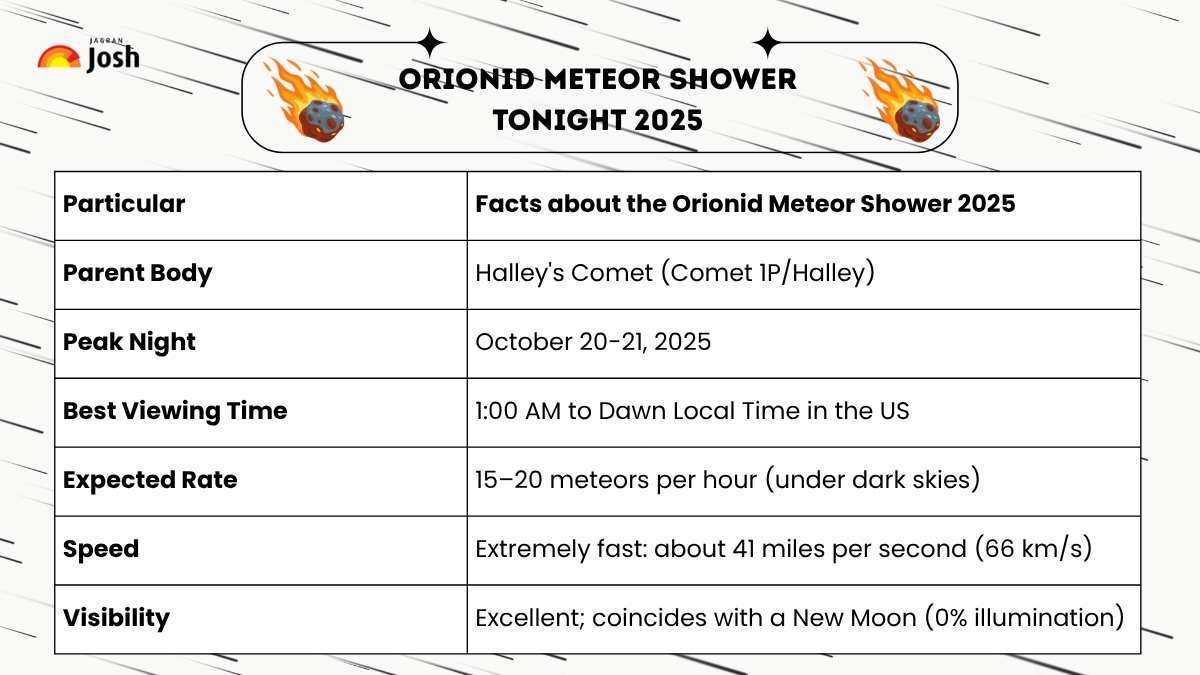Orionid Meteor Shower in the US (2025): Tonight, as Earth moves along its orbit, it is set to pass through a stream of ancient cosmic debris, creating the brilliant Orionid meteor shower. This annual celestial event is particularly special because the "shooting stars" you’ll see are tiny fragments, often no bigger than a grain of sand, from the most famous comet of all: Halley’s Comet (Comet 1P/Halley).
Halley’s Comet swings by Earth only once every 75-76 years, but its dust trail produces two spectacular meteor shows annually, including the Orionids. This year, conditions are ideal with the shower peaking right as the New Moon darkens the sky, ensuring maximum visibility for observers across the US. This makes your chances of catching a bright, fast meteor streaking across the autumn sky the best they can be!

When is the Orionid Meteor Shower Peak Tonight?
If you're asking, "Is there a meteor shower tonight?" the answer is a resounding yes! The Orionid meteor shower has a broad period of activity. Still, its absolute peak is happening right now, making tonight and the early hours of tomorrow the optimal time for viewing.
-
Peak Date: The shower reaches its maximum activity on the night of October 20-21, 2025 (tonight/early morning).
-
Peak Time to Watch (US): The best time to look up is during the pre-dawn hours, specifically between 1:00 AM and dawn (around 4:00 AM to 5:00 AM) Local Time across the US. This is when the constellation Orion, which is the shower's radiant point, is at its highest point in the sky.
-
Maximum Hourly Rate: Under perfectly dark, rural skies, the Orionids typically produce a Zenithal Hourly Rate (ZHR) of about 15 to 20 meteors per hour. Though most years are modest, previous historical bursts have seen rates up to 50–75 per hour, making it always worth a look!
Keep an eye on the night sky in October—you might catch a falling star!
— NASA (@NASA) September 30, 2025
The Orionid meteor shower reaches its peak on the night of Oct. 21-22, and the Draconids will also be visible earlier in the month. Check out what else to watch out for: pic.twitter.com/JlRSzHUlbA
Where to Look to Spot the Orionid Meteors in the US?
The Orionids meteor shower is visible from both the Northern and Southern Hemispheres, making it a worldwide event. For stargazers in the US, knowing where the shower gets its name from is the key to positioning yourself.
The meteors appear to "radiate" from a point near the famous Orion constellation, hence the name.
-
Look East/Southeast: After 10:00 PM local time, the constellation Orion starts to rise in the eastern sky. By the prime viewing hours (1:00 AM to dawn), it will be high in the south-southeast.
-
Spot Orion's Belt: You can find Orion's Belt by looking for three bright stars in a straight line: Alnitak, Alnilam, and Mintaka. The radiant is just north of the bright red star Betelgeuse, which is on Orion's shoulder.
-
Don't Stare at the Radiant: You shouldn't look directly at the bright point, though, because meteors that are close to it leave short, faint trails. Instead, look 45 to 90 degrees away from Orion, scanning a wide area of the darkest sky overhead. The meteors seen here will have the longest, most dramatic trails.
Check Out: Meteor Showers List 2025: When & How to See the Shooting Stars Tonight in the US
How to Watch the Meteor Shower Tonight for the Best View?
You don't need any special gear to see the meteor shower tonight in the US, but you do need to be patient and be in a good spot.
-
Go Dark: Get away from city and street lights. Light pollution is the biggest obstacle. The darker the location, the more meteors you'll see.
-
Lie Back and Relax: Sit back in a comfortable chair or blanket. This lets you look straight up without straining your neck, and it keeps your field of vision wide.
-
Be Patient: Give your eyes at least 20 to 30 minutes to adjust to the dark. Your night vision will significantly improve after this time, allowing you to catch fainter meteors.
-
Moonless Skies are Perfect: The good news for the Orionids peak in 2025 is that it coincides with the New Moon phase on October 21. This means the sky will be optimally dark with virtually no lunar interference!
Also Read - Missed the Draconid Meteor Shower 2025? Check the Orionids Peak Date and Time
Don't miss this incredible opportunity to connect with a piece of cosmic history, as these swift, brilliant Orionid meteors, the dusty leftovers of Halley's Comet, light up the pre-dawn sky. Whether you're in California tonight or on the East Coast, grab your blanket, find a dark spot, and prepare for a spectacular viewing experience of the Orionid meteor shower tonight.
Comments
All Comments (0)
Join the conversation